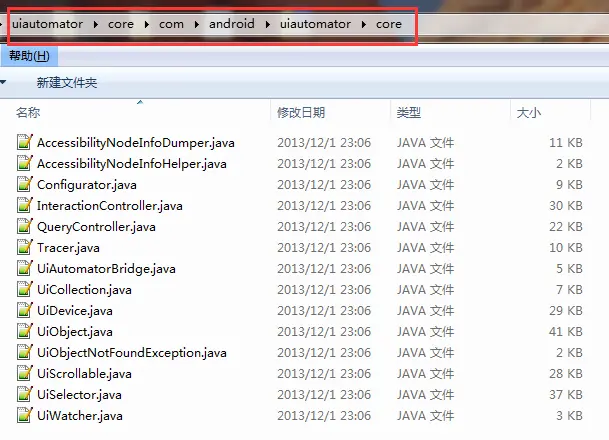我的Uiautomator系列的博客中,没有向其他工具一样介绍源码分析的部分,原因是实在太忙,没时间去细看,草草了事分享给大家又怕把大家带入误区,刚好这里我就简单的说说。首先要下载的同学可以点击这里下载。

image
下载后我们可以在 ..\uiautomator\core\com\android\uiautomator\core 的路径下看到这些代码。
通过仔细的寻找,在** InteractionController.java** 文件中找到了一个看起来很好用的一个方法 performMultiPointerGesture :
/** * Performs a multi-touch gesture
*
* Takes a series of touch coordinates for at least 2 pointers. Each pointer must have
* all of its touch steps defined in an array of {@link PointerCoords}. By having the ability
* to specify the touch points along the path of a pointer, the caller is able to specify
* complex gestures like circles, irregular shapes etc, where each pointer may take a
* different path.
*
* To create a single point on a pointer's touch path
* <code>
* PointerCoords p = new PointerCoords();
* p.x = stepX;
* p.y = stepY;
* p.pressure = 1;
* p.size = 1;
* </code>
* @param touches each array of {@link PointerCoords} constitute a single pointer's touch path.
* Multiple {@link PointerCoords} arrays constitute multiple pointers, each with its own
* path. Each {@link PointerCoords} in an array constitute a point on a pointer's path.
* @return <code>true</code> if all points on all paths are injected successfully, <code>false
* </code>otherwise
* @since API Level 18 */
public boolean performMultiPointerGesture(PointerCoords[] ... touches) { boolean ret = true; if (touches.length < 2) { throw new IllegalArgumentException("Must provide coordinates for at least 2 pointers");
} // Get the pointer with the max steps to inject.
int maxSteps = 0; for (int x = 0; x < touches.length; x++)
maxSteps = (maxSteps < touches[x].length) ? touches[x].length : maxSteps; // specify the properties for each pointer as finger touch
PointerProperties[] properties = new PointerProperties[touches.length];
PointerCoords[] pointerCoords = new PointerCoords[touches.length]; for (int x = 0; x < touches.length; x++) {
PointerProperties prop = new PointerProperties();
prop.id = x;
prop.toolType = MotionEvent.TOOL_TYPE_FINGER;
properties[x] = prop; // for each pointer set the first coordinates for touch down
pointerCoords[x] = touches[x][0];
} // Touch down all pointers
long downTime = SystemClock.uptimeMillis();
MotionEvent event;
event = MotionEvent.obtain(downTime, SystemClock.uptimeMillis(), MotionEvent.ACTION_DOWN, 1,
properties, pointerCoords, 0, 0, 1, 1, 0, 0, InputDevice.SOURCE_TOUCHSCREEN, 0);
ret &= injectEventSync(event); for (int x = 1; x < touches.length; x++) {
event = MotionEvent.obtain(downTime, SystemClock.uptimeMillis(),
getPointerAction(MotionEvent.ACTION_POINTER_DOWN, x), x + 1, properties,
pointerCoords, 0, 0, 1, 1, 0, 0, InputDevice.SOURCE_TOUCHSCREEN, 0);
ret &= injectEventSync(event);
} // Move all pointers
for (int i = 1; i < maxSteps - 1; i++) { // for each pointer
for (int x = 0; x < touches.length; x++) { // check if it has coordinates to move
if (touches[x].length > i)
pointerCoords[x] = touches[x][i]; else pointerCoords[x] = touches[x][touches[x].length - 1];
}
event = MotionEvent.obtain(downTime, SystemClock.uptimeMillis(),
MotionEvent.ACTION_MOVE, touches.length, properties, pointerCoords, 0, 0, 1, 1, 0, 0, InputDevice.SOURCE_TOUCHSCREEN, 0);
ret &= injectEventSync(event);
SystemClock.sleep(MOTION_EVENT_INJECTION_DELAY_MILLIS);
} // For each pointer get the last coordinates
for (int x = 0; x < touches.length; x++)
pointerCoords[x] = touches[x][touches[x].length - 1]; // touch up
for (int x = 1; x < touches.length; x++) {
event = MotionEvent.obtain(downTime, SystemClock.uptimeMillis(),
getPointerAction(MotionEvent.ACTION_POINTER_UP, x), x + 1, properties,
pointerCoords, 0, 0, 1, 1, 0, 0, InputDevice.SOURCE_TOUCHSCREEN, 0);
ret &= injectEventSync(event);
}
Log.i(LOG_TAG, "x " + pointerCoords[0].x); // first to touch down is last up
event = MotionEvent.obtain(downTime, SystemClock.uptimeMillis(), MotionEvent.ACTION_UP, 1,
properties, pointerCoords, 0, 0, 1, 1, 0, 0, InputDevice.SOURCE_TOUCHSCREEN, 0);
ret &= injectEventSync(event); return ret;
}对这个方法解释一下吧:模拟一个多触摸的手势。至少两个点进行一系列的触摸操作,每一个滚动轨迹的点集都需要使用在 PointerCoords 数组中实现它所有的步骤,顺着轨迹指针的路径进行模拟触摸,调用者是能够指定进行完成复杂的手势,例如画圈,不规则形状,其中每个点都可以有不同的路径。(解释的我自己都看不下去了)
废话不说了,直接上我的实战代码吧:
private void zoomin() {
UiDevice mdevice = getUiDevice();
int h = mdevice.getDisplayHeight();
int w = mdevice.getDisplayWidth();
System.out.println("h: " + h + " w: " + w);
MultiPointerGesture(w / 2 - 100, h / 2 - 100, w / 2 + 100, h / 2 + 100);
}
private void MultiPointerGesture(int x1, int y1, int x2, int y2) {
PointerProperties[] properties = new PointerProperties[2];
PointerProperties pp1 = new PointerProperties();
pp1.id = 0;
pp1.toolType = MotionEvent.TOOL_TYPE_FINGER;
PointerProperties pp2 = new PointerProperties();
pp2.id = 1;
pp2.toolType = MotionEvent.TOOL_TYPE_FINGER;
properties[0] = pp1;
properties[1] = pp2;
PointerCoords[] pointerCoords = new PointerCoords[2];
PointerCoords pc1 = new PointerCoords();
pc1.pressure = 1;
pc1.size = 1;
pc1.x = x1;
pc1.y = y1;
PointerCoords pc2 = new PointerCoords();
pc2.pressure = 1;
pc2.size = 1;
pc2.x = x1;
pc2.y = y1;
pointerCoords[0] = pc1;
pointerCoords[1] = pc2;
PointerProperties[] properties2 = new PointerProperties[2];
PointerProperties pp12 = new PointerProperties();
pp12.id = 0;
pp12.toolType = MotionEvent.TOOL_TYPE_FINGER;
PointerProperties pp22 = new PointerProperties();
pp22.id = 1;
pp22.toolType = MotionEvent.TOOL_TYPE_FINGER;
properties2[0] = pp12;
properties2[1] = pp22;
PointerCoords[] pointerCoords2 = new PointerCoords[2];
PointerCoords pc12 = new PointerCoords();
pc12.pressure = 1;
pc12.size = 1;
pc12.x = x2;
pc12.y = y2;
PointerCoords pc22 = new PointerCoords();
pc22.pressure = 1;
pc22.size = 1;
pc22.x = x2;
pc22.y = y2;
pointerCoords2[0] = pc12;
pointerCoords2[1] = pc22;
PointerCoords[][] ppCoords = new PointerCoords[2][];
ppCoords[0] = pointerCoords;
ppCoords[1] = pointerCoords2;
UiDevice device = UiDevice.getInstance();
Class UiDevice_class = UiDevice.class;
Field field_UiD;
try
{
field_UiD = UiDevice_class.getDeclaredField("mUiAutomationBridge");
field_UiD.setAccessible(true);
Object uiAutomatorBridge;
uiAutomatorBridge = field_UiD.get(device);
Class tmp = Class.forName("com.android.uiautomator.core.UiAutomatorBridge");
Field field = tmp.getDeclaredField("mInteractionController");
field.setAccessible(true);
Object interactionController = field.get(uiAutomatorBridge);
Class ijClass = interactionController.getClass();
Method method = null;
try
{
method = ijClass.getDeclaredMethod("performMultiPointerGesture", new Class[] { PointerCoords[][].class });
} catch (NoSuchMethodException e)
{
// method =
// ijClass.getDeclaredMethod("performMultiPointerGesture", new
// Class[]{PointerCoords[].class);
}
method.setAccessible(true);
method.invoke(interactionController, new Object[] { ppCoords });
} catch (NoSuchFieldException e)
{
e.printStackTrace();
} catch (SecurityException e)
{
e.printStackTrace();
} catch (IllegalArgumentException e)
{
e.printStackTrace();
} catch (IllegalAccessException e)
{
e.printStackTrace();
} catch (InvocationTargetException e)
{
e.printStackTrace();
} catch (ClassNotFoundException e1)
{
e1.printStackTrace();
}
}可以看到当时花了很大的代价,都用到了反射机制,最终发现Uiautomator对外暴露了这个接口,真是让人哭笑不得啊。。





















 931
931

 被折叠的 条评论
为什么被折叠?
被折叠的 条评论
为什么被折叠?








